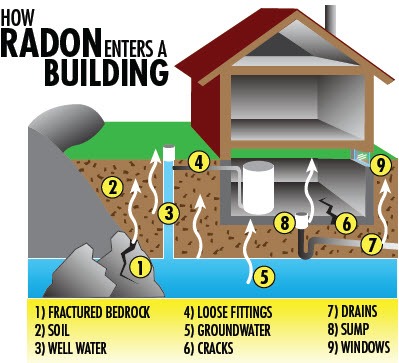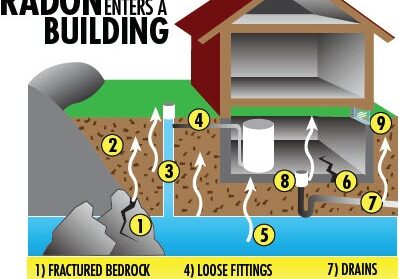The U.S. Environmental Protection Agency (EPA) ranks indoor radon among today’s most serious environmental health problems. Although there currently are no mandatory radon testing requirements for New Jersey schools, the New Jersey Department of Environmental Protection (DEP) strongly encourages school districts to test voluntarily to identify and correct any radon problems that might exist.
To date, approximately half of New Jersey’s public schools have been tested, and 8 percent had at least one room with radon levels over the trigger for reducing concentrations.
A local association should work with its UniServ field representative to find out if its school district has performed radon testing. If so, the local should review the results. If not, the local should ask the district to perform testing. If testing results show the need for mitigation, the local should ask the school district to do so. Parents are likely to make good allies to school staff on this issue.
How radon enters school buildings

Radon is a naturally occurring radioactive gas formed by the natural decay of uranium in rock, soil, and water. Radon is invisible, odorless, and tasteless and can only be detected through specialized tests. Many factors can contribute to the entry of radon gas into a school building, which can ultimately result in unhealthy levels. These include the concentration of radon in the soil; the permeability of the soil under the school; the structure and construction of the school building; and the type, operation, and maintenance of the heating, ventilation and air-conditioning (HVAC) system.
Many schools are constructed on adjoining floor slabs that allow radon gas to enter through construction and expansion joints between the slabs. Other entryways include crawl spaces, utility tunnels, subslab HVAC ducts, cracks, or other penetrations in the foundation, small openings around pipes, and sump pits.
Radon and lung cancer
Radon decays into radioactive particles that can get trapped in your lungs when you breathe. As these particles break down, they release small bursts of energy. This can damage lung tissue and potentially cause lung cancer.
Radon is a leading cause of lung cancer, second only to cigarette smoking, resulting in approximately 22,000 deaths in the United States every year. Approximately 2,900 of those diagnosed with radon-induced lung cancer have never smoked. If you smoke, your risk of developing lung cancer is even greater.
Testing is key The DEP testing protocol requires that all frequently occupied rooms, such as classrooms and offices, that are in contact with the ground, or are directly above unoccupied areas of the basement, be tested with the windows and doors closed. The cost of testing is $20-$50 per room, including test devices and laboratory costs if conducted by a New Jersey certifi ed radon business.
Temporary structures used as classrooms should be tested if the classroom flooring is in direct contact with the ground or above an enclosed space (such as a crawl space or bricked-in foundation) that would allow radon gas to collect.
When a district opts to test for radon, state law requires that the buildings be tested by a certified radon business. To reduce costs, school officials may obtain an exemption from the DEP that allows them to designate one or more school employees to conduct the testing instead. While this will result in lower costs of $10 to $25 per room, it shifts the responsibility for proper testing to school officials and the school district.
To qualify for an exemption, school officials must follow specific protocols, including the successful completion of a DEP-approved training course by the designated employees. Such employees may conduct testing in that school district only.
To notify parents and staff of test results, the DEP recommends that the results of radon testing be posted in a public area along with a DEP fact sheet that will enable interpretation the results.
Mitigation
Mitigation involves increasing ventilation, sealing entry points such as the foundation, subslab depressurization, and other techniques. Mitigation work must be conducted by a state-certified mitigation business.
The EPA recommends mitigation if radon test results show levels at 4 picocurie per liter (pCi/L) or more. A picocurie per liter is a measure of radioactivity in the air. In New Jersey, approximately 8 percent of schools tested had at least one room with a result of 4.0 pCi/L or higher. The highest concentration of radon found in a New Jersey school was 79.9 pCi/L.
It’s important to note that this action level was established because it was technologically achievable at the time, not because it entirely eliminates the risk from radon exposure. There is no truly safe level of radon since lung cancer can result from low exposures; however, the risk decreases as the radon concentration decreases.
Homes should also be tested
While it’s important to test schools for radon, it’s also vital to test homes. When considering the risk to children and school staff, keep in mind that most of their time is spent at home where high radon levels can also pose a big threat.
NIOSH establishes injury and illness goals
The National Institute of Occupational Safety and Health (NIOSH) has developed goals to reduce the frequency and severity of injuries and illnesses among school-based workers by 2015.
The goals were developed for the education sector through the National Occupational Research Agenda (NORA) Service Sector Councils. The National Education Association participated.
- Ensure that injuries and illnesses are recorded and tracked to identify risks.
- Create guidance documents for hazard identification, hazard control, and indoor air quality.
- Characterize chemical, biological, and physical hazards in school environments such as classrooms, science laboratories, art studios, kitchen and cafeterias, music rooms, sports arenas, school buses, transportation facilities, and parking areas.
- Deliver best practice guidelines for school construction and renovations.
- Characterize work organization elements that may put workers at risk of illness such as chronic demand and control imbalances, inadequate communication, and poorly implemented safety/violence programs.
- Identify essential components of effective occupational safety and health programs for dissemination throughout the education industry.
- Deliver guidelines through partner organizations. To learn more, see Safety and Health in Education and Schools, December 2009, www.cdc.gov/niosh/docs/2010-120.
For more information
For detailed information and related links for school testing procedures and interpretation of test results, exemption program requirements, fact sheet for school staff and parents, as well as a list of certified radon testing and mitigation businesses, visit the DEP’s radon website at www.njradon.org and click on “Radon in Schools” under “Information on Radon in Schools and Day Care Centers.”
